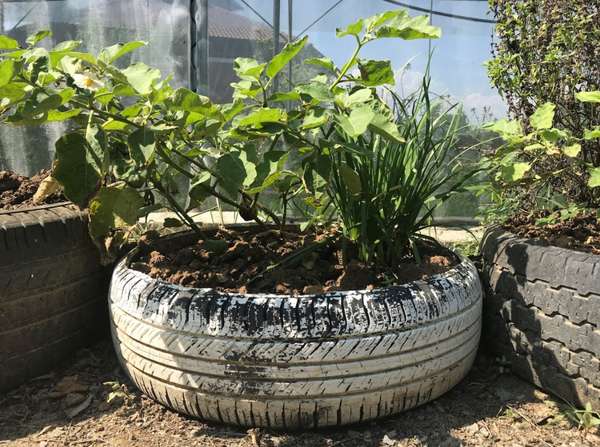Tire gardens have many good uses, including growing a variety of crops where only concrete or poor soils exist, such as urban gardens, homegardens, and refugee camp settings. They can be raised onto supports to keep vegetables out of reach of livestock, and have also been used for vermicompost bins among other things. Tire planters make nice additions to many kitchen gardens around the world, being accessible right out the front door. Best of all, they are a cheap raised bed, and reuse an otherwise voluminous waste product.
where only concrete or poor soils exist, such as urban gardens, homegardens, and refugee camp settings. They can be raised onto supports to keep vegetables out of reach of livestock, and have also been used for vermicompost bins among other things. Tire planters make nice additions to many kitchen gardens around the world, being accessible right out the front door. Best of all, they are a cheap raised bed, and reuse an otherwise voluminous waste product.
We use them at the ECHO Global Farm in the US for growing perennials and annuals, including fruit trees and seed crops. Tires are not used exclusively by ECHO, but have been promoted by our partners in many places, as appropriate container options.
An emerging question is whether or not they are a safe option for planting edible crops. Is it possible that plants take up heavy metals or other toxic elements present in the tire?
To begin seeking out an answer, we first tested soil and garlic chive samples that had spent 20 years in a tire on the ECHO Global Farm in Florida. We compared these to soil and garlic chive samples planted directly in the ground on another section of the farm known as the Lowlands. These were our results:
Tire Garlic Chives: 1.17 ppm lead
Tire Soil: 9.88 ppm lead
Lowlands Garlic Chives: Below Detectable Levels
Lowlands Soil: 4.28 ppm lead
The World Health Organization (WHO) points out that there is no known, safe level of lead for small children (WHO 2018). According to international food standards, leafy vegetables should not have more than 0.3 ppm lead (FAO/WHO 2015). Twenty years of perennial garlic chives in the same tire is a worst case scenario, but if a perennial is planted in a tire, it is a lot of work to move them and tires last a long time. One could feasibly leave a plant for a decade or two.
The Environmental Protection Agency (EPA) in the United States notes that soil normally contains lead at less than 50 ppm (ATSDR 2017; Grubinger and Ross 2011). Lead concentration in our soil is well below 50 ppm, suggesting that the garlic chives have picked up the lead from some other source or for some other reason. We do not know whether the roots in contact with the tire wall or pooled leachate in the tire rim is the cause, or whether a lack of nutrients caused the roots to uptake heavy metals. Both may have contributed.
The question now is how long does it take for the heavy metal contaminants to build up to a dangerous level? We are beginning to test this at ECHO Asia Small Farm Resource Center in Chiang Mai, Thailand by setting up an observational trial for 10 tires. Over the next 10 years, the research staff will test the soil every year for either lead, cadmium, or chromium on a rotating basis. If the soil is contaminated, we will test the garlic chives planted in the tires.
This experiment is designed to define the boundaries of risk and what should be studied more. We are comparing worst case scenarios, including (1) extremely degraded tires, (2) tires treated to prevent contamination–by turning the tires inside out, (3) lining tires with plastic, or (4) painting them. We also have an untreated tire to see a ‘normal’ situation and two plastic containers as controls.
We took baseline data for this experiment at ECHO Asia and found our garlic chives—recently transplanted from a raised bed into tires–are below 0.05 ppm, as close to the previously-mentioned maximum allowable limit of 0.3 ppm as we could measure. Our initial soil mix is at 20.33 ppm. This is double the level in the 20-year-old tire’s soil in Florida (9.88 ppm), but still within the EPA’s normal limit of 50 ppm.
Over time oECHO Asia will provide updates to share what we have found about tire safety: whether the lead levels increase or stay the same. To our knowledge, no one has made significant effort to study this question in depth, so even our initial results of the 20-year old garlic chives will add to the conversation.
Below is some information referenced above and for further reading. Please let us know if you have any other thoughts, particularly insights on knowing the risks of gardening in tires and how to minimize those.
REFERENCES
Information on Thresholds of Heavy Metal in Soil:
Ministry of the Environment, Finland, 2007. Government Decree on the Assessment of Soil Contamination and Remediation Needs
Agency for Toxic Substances and Disease Registry. 2017. Case Studies in Environmental Medicine (CSEM): Lead Toxicity
Grubinger, V. and D. Ross, 2011. Interpreting the Results of Soil Tests for Heavy Metals. University of Vermont Extension 1.
Fisher, B. and ECHO staff. 2016. Tire Contaminants from a Container Gardening Perspective 1. ECHO Development Notes 130:1-3
Information on Thresholds of Heavy Metal in Plant Tissue:
FAO/WHO (2015). General standards for contaminants and toxins in food and feed (CODEX STAN 193-1995)
Information on Lead Poisoning and Human Health:
WHO. 2018. Lead poisoning and health 1